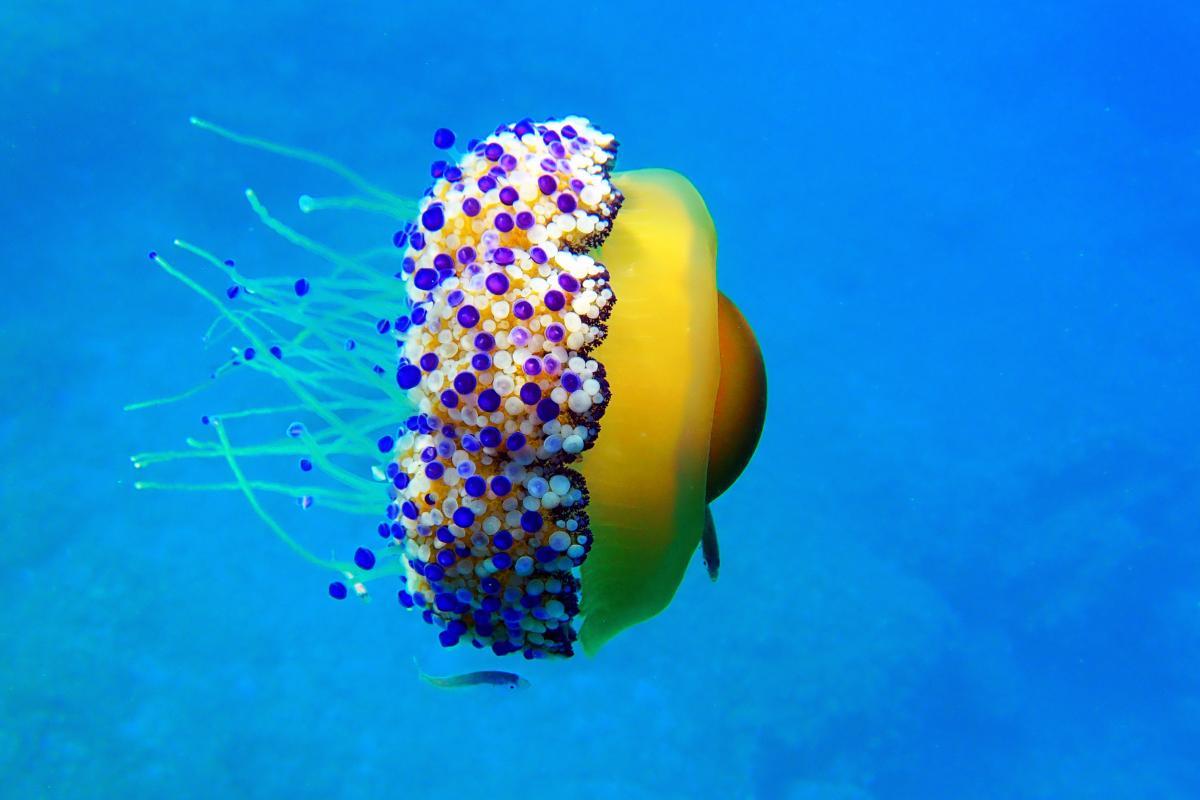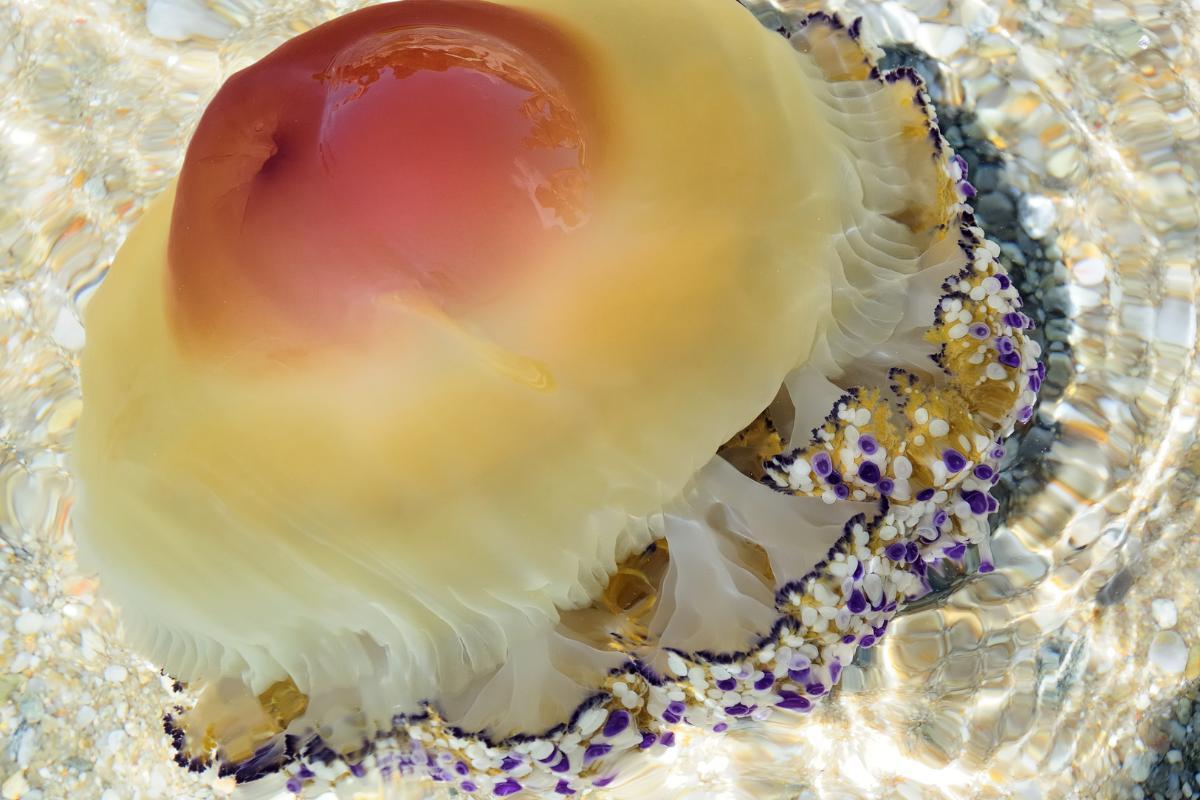Are Fried Egg Jellyfish Poisonous?


Also known as the Mediterranean jellyfish, the friend egg jellyfish (Cotylorhiza tuberculata) is the medusa stage of a sea jelly which lives mainly in European waters. Its common name is thanks to its distinctive shape and coloring, giving it the appearance of a fried chicken egg. The umbrella or bell of the main body has a yellowish ring with an orange dome in the middle, similar to the albumen and yolk of a friend egg. Although beautiful and mysterious, jellyfish are known to have a sting. This leads thedailyECO to ask, are fried egg jellyfish poisonous?
Is the fried egg jellyfish sting poisonous?
When asking if any jellyfish is poisonous, we are actually asking if they are venomous. Many jellyfish contain toxins in their tentacles which we know as venom. These are usually longer than the umbrella of their body from which they hang down.
Jellyfish release their venom through specialized structures called cnidocytes or cnidoblasts, specialized cells which contain one organelle known as a cnidocyst. The cnidocyst is a secretory organelle, meaning it can release certain compounds when agitated. These compounds contain toxins which can vary greatly in terms of potency. Although rare, some are sufficiently venomous that they can kill a human in the right circumstances.
Fortunately, the fried egg jellyfish is not a deadly sea jelly. While they do contain some toxins, they are relatively mild and there are no known instances of it causing the death of a human. This does not mean that the Mediterranean jellyfish has no sting. If we are to come in contact with their tentacles, the stinging cells cause irritation and burning of the skin. These stingers are used as a defense mechanism against predators, including ourselves.
If you are wondering if fried egg jellyfish is dangerous, it does not pose a significant danger to people's health. From a toxicological point of view, it is considered a low-toxic jellyfish species. It can cause discomfort when found in large quantities on a beach. Stings from this jellyfish are very rare. When they do occur, they are usually mild. In fact, it is likely that many people have been stung by this jellyfish without being aware of it.
Learn more about the jellyfish found around Europe with our article on the types of Mediterranean jellyfish.

What to do if you are stung by a fried egg jellyfish
As we have stated, it is possible a friend egg jellyfish sting is practically asymptomatic. However, if someone is sensitive to jellyfish stings or they have received multiple stings in the same area, they may develop the following symptom:
- Sharp pain, intense itching, redness and swelling in the affected area.
- Hives and erythema (redness of the skin) may appear.
- In more severe cases, the skin can become ulcerated or even necrotic.
- In severe situations, the poison can spread throughout the body, which can cause chest tightness, muscle cramps and even difficulty breathing.
- In particularly sensitive people, such as the elderly or people with serious illnesses, symptoms may be more intense and require immediate medical attention.
However, these severe symptoms are rare and there are no known fatalities from a Mediterranean jellyfish sting. If we are stung and experience a reaction, we should start by washing it with a sterile saline solution. Seawater may help, but it may also contain bacteria and other microbes which can worsen the lesion. Cold compresses should be applied for about 15 minutes after the sting to reduce swelling and discomfort.
It is crucial to check if there are any remains of the tentacles attached to the skin and remove them with tweezers. Do not touch them directly. Finally, antihistamines can be given to reduce allergic reactions and analgesics to relieve pain.
How to avoid a fried egg jellyfish sting
Fried egg jellyfish are a fascinating species found on Mediterranean coasts during the summer, but their stings can cause discomfort to bathers. Knowing the characteristics of these jellyfish and how to act in case of a sting will help us enjoy the sea with greater peace of mind and safety.
To minimize the risk of stings, it is important to pay attention to flags and warnings on beaches. Areas with a high presence of these jellyfish should be avoided. If necessary, a neoprene suit or a specific cream can be used to act as a protective barrier. Special care should be taken with children and the elderly who are more vulnerable to bites.
Taking these preventive measures into account and knowing how to act in the event of a bite, we will be able to enjoy the sea with greater peace of mind and safety during the summer season.

Characteristics of fried egg jellyfish
This species of animal is undoubtedly one of the most peculiar, even among jellyfish. Some fun facts about the fried egg jellyfish are the following:
- As their name suggests, the fried egg jellyfish has a deep yellow color and a smooth surface with a central hemispherical elevation. Its edge does not have tentacles and its perimeter is divided into 16 lobes.
- It has a domed umbrella (body) in the center that has a paler surface around it.
- It has a total of 8 tentacles covered with small button-shaped protuberances, with a color that combines white, blue and violet.
- On average, the size of the fried egg jellyfish is 8" (20 cm) in diameter, but it can measure up to 16" (40 cm).
- These jellyfish are capable of swimming vertically by contracting and expanding their body. They can also move horizontally, being able to easily turn to move through the sea.
- In addition to consuming small fish and other species of jellyfish, they can also feed on sunlight.
Now that we know more about Cotylorhiza tuberculata, it is also important to mention where the fried egg jellyfish lives. The fried egg jellyfish is a species that does not normally dive to great depths. During the summer, it is common to observe these jellyfish on the coasts of the Mediterranean Sea. When winter arrives and temperatures drop, the species moves towards deeper waters, away from the coast.
An interesting fact is that in order to carry out its reproductive cycle, the fried egg jellyfish requires a rocky substrate. This need brings them closer again to the coastal areas of the Mediterranean, where they can find the appropriate conditions to reproduce.
Now that you know whether the fried egg jellyfish is poisonous, you may want to learn more about jellyfish anatomy with our article on whether jellyfish have brains.
If you want to read similar articles to Are Fried Egg Jellyfish Poisonous?, we recommend you visit our Facts about animals category.
- Brotz, L. et al. (2012). Jellyfish populations in the Mediterranean Sea. ACTA ADRIATICA, 19.
- Mariottini, G. et al. (2010). Mediterranean Jellyfish Venoms: A Review on Scyphomedusae. Marine Drugs, 8(4), 1122-1152. DOI: 10.3390/md8041122







